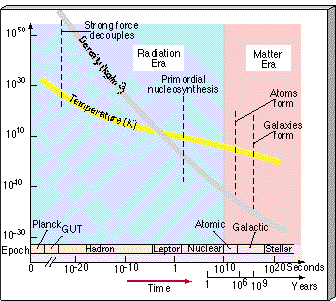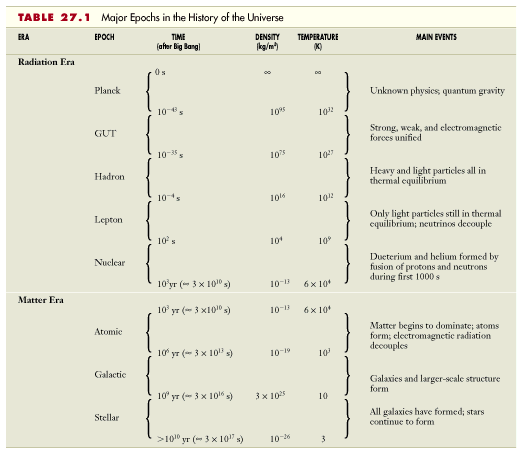For the first few thousand years after the Big Bang, the universe was small and dense and dominated by the effects of radiation. We will refer to this period as the Radiation Era. Some matter existed during this time, but it was a mere contaminant in the blinding radiation of the primeval Big Bang fireball. Afterwards matter came to dominate, in the Matter Era. Atoms, molecules, and galaxies formed as the universe cooled and thinned toward the state we see today.
Let's begin our study of the early universe by summarizing in broad terms the history of the cosmos, starting at the Big Bang. Table 27.1 and Figure 27.4 present the time, density, and temperature spans of eight major epochs in the development of the universe, along with a brief description of the main physical events that dominated the universe during each. The numbers in this table and figure result from pushing the known laws of physics as far back in time as we can. In the next few sections we will expand on some of these epochs in greater detail, but let's not lose sight of the big picture and the place of each epoch in it.

Figure 27.4 The average temperature and average density throughout the history of the universe. The epochs listed in Table 27.1 are indicated. (The numerical values for these plots are taken from Table 27.1.) Some key events in the history of the universe are also marked.
The universe began with an explosion from an incredibly hot and dense state. Precisely what state, we cannot say. And why it exploded, we really don't know. To understand why the universe began expanding, or even more fundamentally, why the universe exists at all, is currently beyond science—there are simply no relevant data. Although ignorant of the moment of creation itself, theorists nevertheless believe that the physical conditions in the universe can be understood in terms of present-day physics back to an extraordinarily short time—a mere 10-43 s, in fact—after the Big Bang.
Why can't theorists push our knowledge back to the Big Bang itself? The answer is that we presently have no theory capable of describing the universe at these earliest of times. Theorists believe that under the extreme conditions of density and temperature within 10-43 s of the Big Bang, gravity and the other fundamental forces (electromagnetism, the strong force, and the weak force, as described in (More Precisely 27-1) were indistinguishable from one another—a far cry from the radically different characters we see today. The four forces are said to have been unified at this early time—there was, in effect, only one force of nature.
The theory that combines quantum mechanics (the proper description of microscopic phenomena) with general relativity (which describes the universe on the largest scales) is generically known as quantum gravity. (Sec. 22.6) The period of time from the beginning to 10-43 s is often referred to as the Planck epoch, after Max Planck, one of the creators of quantum mechanics. Unfortunately, for now at least, there is no working theory of quantum gravity, so we simply cannot talk meaningfully about the universe during the Planck epoch.

By the end of the Planck epoch the temperature was around 1032 K and the universe was filled with radiation and a vast array of subatomic particles created by the mechanism of pair production. At around this time, gravity parted company with the other forces of nature—it became distinguishable from the "quantum" forces, and has remained so ever since. The strong, weak, and electromagnetic forces were still unified. The present-day theories that describe this unification are collectively known as Grand Unified Theories, or GUTs for short (see More Precisely 27-1). Accordingly, we will refer to this period of time as the GUT epoch.
Theory indicates that at temperatures below 1028 K, the strong nuclear force becomes distinguishable from the electroweak force (the unified weak and electromagnetic force). Once the universe had cooled to this temperature, about 10-35 s after the Big Bang, the GUT epoch ended. According to many GUTs, one important legacy of this epoch may have been the appearance and subsequent freeze-out of a veritable "zoo" of very massive (and as yet unobserved) elementary particles which interact only very weakly with normal matter. These "exotic" particles are prime candidates for the dark matter of unknown composition known to exist in abundance both within galaxies and in the unseen depths of intergalactic space.
Our next major subdivision of the Radiation Era covers the period when all "heavy" elementary particles—that is, all the way down in mass to protons, neutrons, and their constituent quarks—were in thermal equilibrium with the radiation. We refer to this period as the hadron epoch, after the general term for particles that interact via the strong force.
The universe continued to expand and cool. At a temperature of about 1015 K, 10-10 s after the Big Bang, the weak and the electromagnetic components of the electroweak force began to display their separate characters. By about 0.1 milliseconds (10-4 s) after the Big Bang, the temperature had dropped well below the 1013 K threshold for the creation of protons and neutrons (the lightest hadrons), and the hadron epoch ended. The main constituents of the universe were now lightweight particles—muons (see More Precisely 27-1), electrons, neutrinos, and their antiparticles—all still in thermal equilibrium with the radiation. Compared with the numbers of these lighter particles, only very few protons and neutrons remained at this stage because most had been annihilated.
Electrons, muons, and neutrinos are collectively known as leptons, after the Greek word meaning "light" (that is, not heavy). Accordingly, this period in the history of the universe is known as the lepton epoch. Quite early on in this epoch, the rapidly thinning universe became transparent to neutrinos. These ghostly particles have been streaming freely through space ever since—most have not interacted with any other particle since the universe was a few seconds old. The lepton epoch ended when the universe was about 100 s old and the temperature fell to about 1 billion K—too low for electron—positron pair production to occur. The density of the universe by this time was about 10 times that of water.
The final significant event in the Radiation Era occurred when protons and neutrons began to fuse into heavier nuclei. At the start of this period, which we will call the nuclear epoch, the temperature was a few hundred million kelvins, and fusion occurred very rapidly, forming deuterium and helium in quick succession before conditions became too cool for further reactions to occur. By the time the universe was about 15 minutes old, much of the helium we observe today had been formed.
Time passed, the universe continued to expand and cool, and radiation gave way to matter as the dominant constituent of the universe. Our next major epoch extends in time from a few thousand years (the end of the Radiation Era) to about 1 million years after the Big Bang. As the primeval fireball diminished in intensity, a crucial change occurred—perhaps the most important change in the history of the universe. At the end of the nuclear epoch, radiation still overwhelmed matter. As fast as protons and electrons combined, radiation broke them apart again, preventing the formation of even simple atoms or molecules. However, as the universe expanded and cooled, the early dominance of radiation eventually ended. Once formed, atoms remained intact. We will call this period the atomic epoch.
The last two epochs together bring us to the current age of the universe. During these late stages, change happened at a much more sedate pace. By the time the universe was about a billion years old, galaxies and large-scale structure had formed. For the first time the visible universe departed from homogeneity on macroscopic scales. The largely uniform universe of the Radiation Era became a universe containing large agglomerations of matter. We call the period from 106 to 109 years after the Big Bang the galactic epoch. At its end, quasars were shining brightly and the first stars were burning and exploding, helping to determine the future shape of their parent galaxies. Since then, stars, planets, and life have appeared in the universe. This final stellar epoch has been the subject of the first 25 chapters of this book.